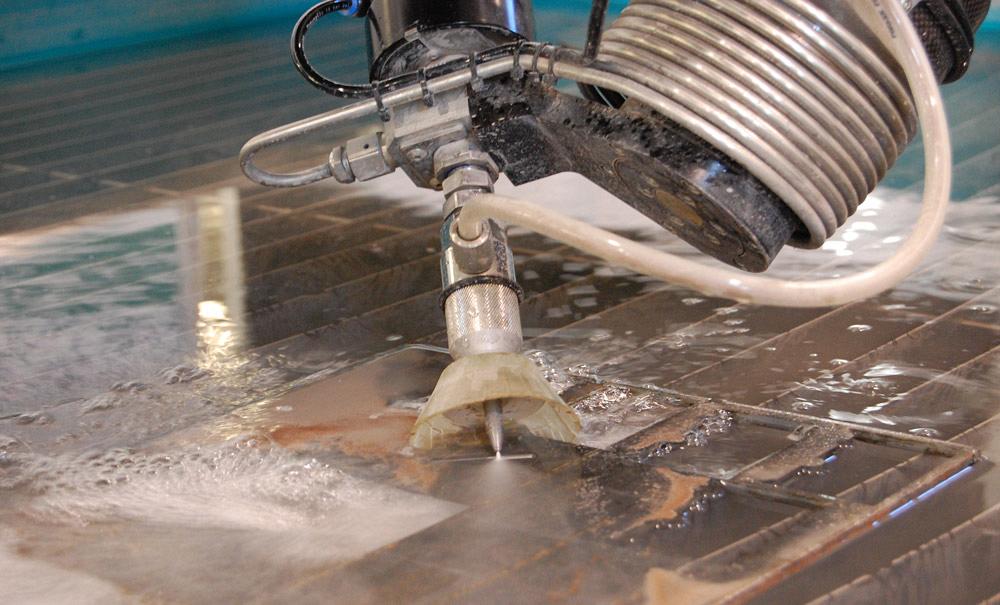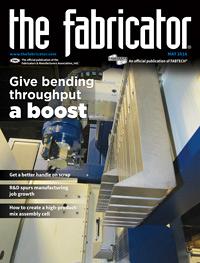National Sales Manager, U.S.
- FMA
- The Fabricator
- FABTECH
- Canadian Metalworking
Categories
- Additive Manufacturing
- Aluminum Welding
- Arc Welding
- Assembly and Joining
- Automation and Robotics
- Bending and Forming
- Consumables
- Cutting and Weld Prep
- Electric Vehicles
- En Español
- Finishing
- Hydroforming
- Laser Cutting
- Laser Welding
- Machining
- Manufacturing Software
- Materials Handling
- Metals/Materials
- Oxyfuel Cutting
- Plasma Cutting
- Power Tools
- Punching and Other Holemaking
- Roll Forming
- Safety
- Sawing
- Shearing
- Shop Management
- Testing and Measuring
- Tube and Pipe Fabrication
- Tube and Pipe Production
- Waterjet Cutting
Industry Directory
Webcasts
Podcasts
FAB 40
Advertise
Subscribe
Account Login
Search
Right-size your waterjet cutting machine
Which size and horsepower are right for your shop?
- By Jim Fields
- April 27, 2016
- Article
- Waterjet Cutting
When it comes to waterjet cutting, one size does not fit all. Every waterjet configuration has its advantages and weaknesses, and you need to consider many variables to determine which is right for your business. Among them are plate size (width, length, and thickness), part sizes, cycle time, downtime, load/unload time, and the cost per part.
What is the “right-size” waterjet for your shop? Do you work in a production shop interested in volume jobs or a job shop interested in performing a variety of jobs efficiently? Many waterjet tables can handle both high-volume and job shop work, but they may not handle each equally well.
Production Versus Productivity
First, consider your production and productivity needs. The two terms can mean different things at different times, but in this article production refers to quantity—a measure of output produced. The emphasis is not on how well resources are utilized. In other words, you can produce a lot of parts with many machines, but the cost to do so would be much higher than on a machine that’s the right size for the job.
You can increase production by adding horsepower as well as cutting heads and another work zone for loading/unloading. But unless your input cost is lower than the output value, you don’t make any profit. This is why “production at any cost” would send us all to the poor house.
Productivity concerns not merely the total value or volume of output, but also the efficiency of the production. The same variables come into play here, but you have to factor in efficiency of the whole operation. So in addition to loading/unloading, horsepower, and the number of cutting heads, you must also look at downtime—or, in waterjet terms, noncutting time.
Manage Your Downtime
First, tackle the low-hanging fruit. Time the events that occur from the last good part of the previous job to the first good part of the next job. Is the operator waiting for raw material? If so, could raw plates be stored or staged near the point of use? When the job arrives, is the waterjet operator missing any information, and if so, how much time does he take to find that information? How much time does it take to program the machine? Is the machine down for reactive maintenance?
After this, consider your equipment options. Many job shops add pump horsepower to increase productivity. As you add horsepower, you can cut faster and run multiple heads. This frees up more time for loading/unloading without compromising machine output over a given period of time.
But increasing horsepower isn’t the only way to boost productivity. Let’s consider all waterjet production to be equal at the nozzle. Each machine has the same pressure, horsepower, and garnet producing identical cuts. Given this, the only way to increase productivity is to manage the downtime.
To do so, you must decrease maintenance frequency, shorten the time that’s required to perform maintenance, simplify job setup (programming), increase the speed between cuts (rapid traverse), and eliminate unplanned work stoppages (for example, if you run out of garnet unexpectedly).
Material loading/unloading also adds downtime between jobs, which increases your noncutting time and decreases your productivity. The downtime can be significant if you’re dealing with large or heavy fabrications. If you need improved productivity, you may choose simply to buy a second machine—but this isn’t the only option. Some waterjet table configurations have two work zones. This allows you to retrieve parts from one work zone while the other work zone is running.

Figure 1
This dual-tank waterjet arrangement allows operators to place parts on one work zone without disturbing the cutting operation in the active work zone.
Table sizes generally coincide with plate sizes: 4 by 8 feet, 5 by 10 ft., 6 by 12 ft., and so on. As you get into smaller tables, you need to use material that has to be cut down to fit on the table. For this reason, you want a table that will fit your most common sheet or plate size.
Waterjet systems come in a variety of configurations, with either a single work zone or dual work zones. So when does a dual work-zone arrangement make sense? You usually can justify it when floor space allows for it and the load/unload time approaches the time it takes to cut the parts on the table.
Which should you choose? This of course depends on your application, but knowing the available options should give you a head start.
An Additional Machine
Most shops load a standard waterjet machine to capacity and then look at adding a second machine. They usually start with a standard machine—that is, one with a single work envelope and one tank. Table sizes of 5 by 10 ft. or 7 by 13 ft. handle most typical part sizes and work for the vast majority of job shops. These operations consider the loading/unloading time as a cost of doing business.
Another machine often gives a shop the best gains in productivity, versatility, and reliability. Two machines give you redundancy: two pumps, two controllers, and two tables on which you can run different jobs or the same job.
Large Work Envelope, Single Tank, Dual Work Zone
The main factors for this configuration are plate and part size. These tables are usually 10 by 20 ft. or larger. If a shop requires such a machine, it usually is handling larger plate and part sizes. These tables are also used when shops run and load two plates at the same time.
These tables can be split into two work zones with limit switches and/or safety light curtains to keep operators out of the active work zone. Note that the table is still one big work area. You can get into a situation in which plates and parts being loaded and unloaded in one work zone send vibration and movement to the plate being cut in the active work zone.
Large Work Envelope, Independent Tanks
Heavy-duty waterjets cut extremely thick material, so it’s entirely possible that an operator will mishandle a large part. It’s a real-world production reality.
This is why, if your shop has applications that justify dual work zones, having two independent tanks may be a preferred configuration (see Figure 1). Independent tanks boost productivity and help maintain good quality. Dropping a large part on the slats of one tank won’t disrupt the cutting taking place over the other tank.
Using the same motion equipment and pump with two separate tanks allows for loading/unloading during cutting and eliminates the risk of moving the plate being cut in the other tank. To cut especially large parts, an operator can adjust this configuration into one large work zone.
Weighing the Options
Be sure to consider all the factors when choosing the work envelope for your waterjet operations. Most choose large table sizes not necessarily to increase productivity, but to accommodate large plates and parts. But there can be an element of productivity to consider, especially when it comes to dual work zones and the load/unload times.
To get the most out of your waterjet, make sure you look at all the features that will minimize your downtime and increase throughput. If you have large plates or parts, you obviously need a large work zone. In many cases, a dual work zone on a large table may make sense, especially if you have a range of different plate and part sizes.
Alternatively, more cutting heads and horsepower will allow you to cut more in less time. At the same time, waterjet noncutting time over a shift will increase, because you’ll be placing more plates and removing more parts and skeletons.
In this case, it goes back to your production needs. If more horsepower gives you enough excess capacity on the waterjet, the increased downtime still won’t compromise the machine output you need. Alternatively, a dual work zone arrangement will help you shorten or eliminate the downtime. The benefits can be great, especially as the load times approach the cutting cycle time.
But again, you need to weigh the cost of this investment against the alternatives. On the one hand, how much downtime do you add versus the cutting time you eliminate by adding more horsepower? On the other hand, how much downtime do you save with a dual work zone arrangement? And how does each compare with the capital investment required?
At the end of the day, it’s about how quickly a part flows through the entire waterjet cutting process, from raw plate retrieval through cutting and parts handling to the next operation—all achieved at a cost that makes business sense.
Available space and capital budget are your first considerations in identifying the right waterjet size for your shop. Your part size and quantity should be your next consideration. After you weigh the load/unload capabilities against the addition of horsepower, the choice for your situation will become clear.
About the Author
Related Companies
subscribe now

The Fabricator is North America's leading magazine for the metal forming and fabricating industry. The magazine delivers the news, technical articles, and case histories that enable fabricators to do their jobs more efficiently. The Fabricator has served the industry since 1970.
start your free subscription- Stay connected from anywhere

Easily access valuable industry resources now with full access to the digital edition of The Fabricator.

Easily access valuable industry resources now with full access to the digital edition of The Welder.

Easily access valuable industry resources now with full access to the digital edition of The Tube and Pipe Journal.
- Podcasting
- Podcast:
- The Fabricator Podcast
- Published:
- 04/30/2024
- Running Time:
- 53:00
Seth Feldman of Iowa-based Wertzbaugher Services joins The Fabricator Podcast to offer his take as a Gen Zer...
- Industry Events
Pipe and Tube Conference
- May 21 - 22, 2024
- Omaha, NE
World-Class Roll Forming Workshop
- June 5 - 6, 2024
- Louisville, KY
Advanced Laser Application Workshop
- June 25 - 27, 2024
- Novi, MI
Precision Press Brake Certificate Course
- July 31 - August 1, 2024
- Elgin,
































